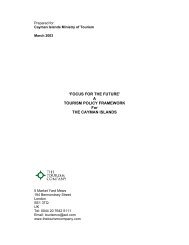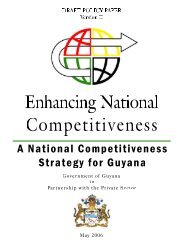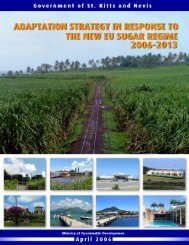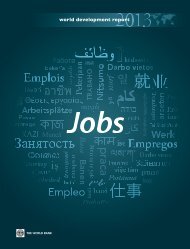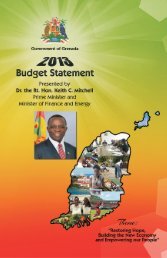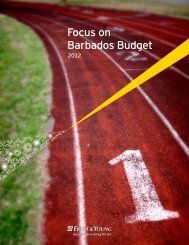Business Removing
Doing Business in 2005 -- Removing Obstacles to Growth
Doing Business in 2005 -- Removing Obstacles to Growth
- No tags were found...
You also want an ePaper? Increase the reach of your titles
YUMPU automatically turns print PDFs into web optimized ePapers that Google loves.
70 DOING BUSINESS IN 2005<br />
Japan have instituted simplified reorganization procedures<br />
for small businesses. Italy has introduced a new rescue<br />
procedure for large businesses—with more than<br />
1,000 employees and debts exceeding US$1 billion. Australia,<br />
Estonia, Finland and Sweden have instituted<br />
streamlined procedures for the liquidation of companies<br />
which lack sufficient assets to complete a regular procedure.<br />
A few other countries do well. Recovery rates in Jamaica,<br />
Mexico and Poland are over 60 cents on the dollar.<br />
In contrast, secured creditors in Brazil, Costa Rica,<br />
the Philippines, and Romania get close to nothing if<br />
their debtor enters bankruptcy. In all of these countries<br />
debtors can enter complex reorganization procedures,<br />
where they are protected from creditors. Reorganization<br />
lasts nearly 6 years in the Philippines and about 4 years<br />
in Costa Rica and Romania. Brazil takes the longest:<br />
creditors can start foreclosure but there are many opportunities<br />
for appeal, each time suspending the process.<br />
It typically takes 10 years. 8<br />
Building an efficient reorganization procedure in<br />
bankruptcy is a luxury. Rich countries can afford it. Few<br />
others can. The differences in recovery rates in a reorganization<br />
procedure between rich and poor countries are<br />
large (figure 9.3). This explains why bankruptcy filings<br />
FIGURE 9.3<br />
Poor countries have low recovery rates<br />
Recovery rate in reorganization<br />
Cents on the dollar<br />
67<br />
Rich<br />
countries<br />
34<br />
Middle<br />
income<br />
Source: Doing <strong>Business</strong> database.<br />
21<br />
Poor<br />
countries<br />
Difference<br />
between rich<br />
and poor<br />
25 TIME<br />
7 COST<br />
14 BUSINESS<br />
KEEPS RUNNING<br />
More time, higher costs<br />
and keeping the business<br />
running account for the<br />
difference.<br />
are so rare outside the OECD, notwithstanding the reforms<br />
of bankruptcy law.<br />
Not all claimants get the full recovery rate. Fiftyeight<br />
countries give the secured creditor priority to the<br />
proceeds. But in Belarus, Burkina Faso, Ecuador and<br />
Oman, taxes and workers all have higher priority than secured<br />
creditors. Recovery rates for these claimants are 15<br />
cents on average. For the secured creditor, only 7 cents.<br />
Who is reforming exit?<br />
In 2003–04 exit became easier in 9 countries: Bulgaria,<br />
Estonia, India, Lithuania, Poland, Romania, Spain,<br />
Tunisia and the United Kingdom. Two countries—<br />
Turkey and Uzbekistan—implemented reform that reduced<br />
efficiency.<br />
Those that succeeded in increasing recovery rates did<br />
so by simplifying existing law. Take Spain. The 2003 reforms<br />
featured three improvements. First, the court can<br />
now order debtors to pay, without entry into bankruptcy.<br />
This reform is estimated to have reduced the number of<br />
frivolous bankruptcy filings by 40%. Second, statutory<br />
deadlines on the duration of procedures are cut in half.<br />
Third, appeals do not suspend the recovery of debt. These<br />
improvements raise the efficiency of Spanish bankruptcy<br />
to that of Hong Kong (China), at 83 cents on the dollar.<br />
Bulgaria also amended its bankruptcy law by reducing<br />
statutory deadlines and cutting opportunities for appeal.<br />
Before, claimants were given 6 months to file claims<br />
once a business declared bankruptcy. Now the limit is 3<br />
months. Before the reform, if the reorganization plan<br />
was rejected by the creditors’ committee, the debtor could<br />
appeal before a general court and then before a superior<br />
court. Now only one appeal is possible. Time to go<br />
through bankruptcy fell by 5 months, with further reduction<br />
expected. Cost was cut in half. Estonia, Lithuania<br />
and the United Kingdom implemented similar reforms<br />
with success.<br />
Poland reformed differently. A court-appointed administrator<br />
takes over the management of the business<br />
once bankruptcy is filed. At a preliminary meeting, the<br />
creditors’ committee decides whether the business should<br />
be reorganized or liquidated. This allows for bankruptcy<br />
to be avoided altogether in cases where the creditors can<br />
agree on foreclosure. It is now also easier to switch between<br />
the two proceedings if the prospects for recovery<br />
change. Time to go through bankruptcy was cut by a<br />
quarter. The recovery rate of bankruptcy in Poland is<br />
now on a par with Portugal’s, at 68 cents on the dollar.<br />
India started ambitious reforms. It repealed the Sick<br />
Industrial Companies Act, which prevented bankrupt<br />
companies from being liquidated. At the same time, it<br />
established specialized bankruptcy tribunals. Twelve are<br />
already in operation, with several dozen to commence



